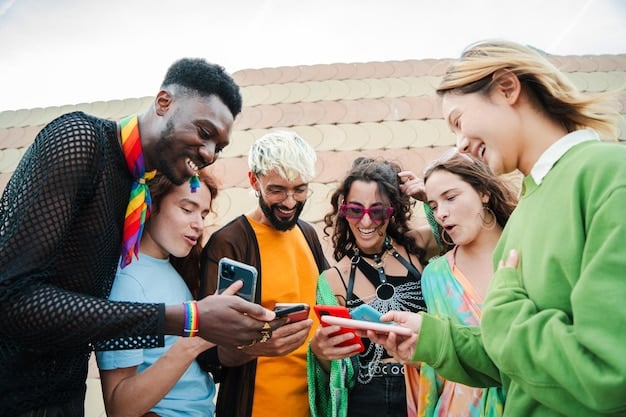Gen Z’s Top 5 Social Media Platforms in the US: Dominating Early 2025

Navigating the ever-evolving digital landscape, Gen Z’s top social media platforms in the US for early 2025 are TikTok, Instagram, YouTube, Snapchat, and newcomer BeReal, with their dominance shaped by unique features, content formats, and community engagement. These platforms are primarily chosen for their authenticity, visual appeal, and ability to foster connections, directly impacting marketing strategies and communication trends within this demographic.
As we approach early 2025, understanding Gen Z’s top 5 social media platforms in the US: Which ones are dominating in early 2025? becomes crucial for marketers, content creators, and anyone seeking to connect with this influential demographic. The digital world is ever-evolving, and Gen Z, often characterized by their digital native upbringing, is at the forefront of these shifts, shaping trends and platforms with their unique preferences and behaviors.
Understanding Gen Z’s Digital Landscape
Gen Z, broadly defined as those born between the mid-1990s and early 2010s, exhibits distinct preferences when it comes to social media engagement. This cohort values authenticity, visual content, and platforms that foster genuine connections over curated, aspirational feeds. Their media consumption habits are fragmented, often involving multiple platforms simultaneously, each serving a different purpose.
Unlike previous generations, Gen Z has grown up with social media deeply embedded in their daily lives, influencing everything from communication to commerce. This omnipresence means their relationship with these platforms is nuanced, driven by both utility and a desire for self-expression and community. Data privacy and mental well-being are also growing concerns for this demographic, subtly influencing their platform choices and usage patterns.
The Shift Towards Authenticity
One of the most significant trends shaping Gen Z’s platform choices is the clear preference for authenticity. Polished, “perfect” content is increasingly giving way to raw, unfiltered, and relatable moments.
- Raw Content: Gen Z gravitates towards content that feels genuine, unedited, and reflects real-life experiences, fostering deeper connections.
- Anti-Influencer Sentiment: There’s a growing skepticism towards traditional influencers, leading to a preference for “micro-influencers” or peers who create more relatable and less commercialized content.
- Community Over Broadcast: While broad reach is still appealing, Gen Z often seeks out smaller communities and niche interests where they can engage more intimately with like-minded individuals.
This pursuit of authenticity extends to how they interact with brands and public figures. They seek transparency and values alignment, making genuine engagement a key differentiator for platforms looking to capture their attention. This focus on the genuine often means they are quicker to adopt new platforms that prioritize these aspects, while older platforms must continually adapt to retain their relevance.
The digital landscape for Gen Z is not static; it’s a dynamic ecosystem where platforms constantly jostle for attention. Understanding the undercurrents of their preferences – authenticity, visual engagement, and community – is key to predicting which platforms will continue to dominate their digital lives in the coming year.
TikTok: The Reigning Short-Form Video Giant
As early 2025 unfolds, TikTok remains an undeniable force in Gen Z’s social media landscape, particularly within the US. Its meteoric rise is attributed to its highly addictive short-form video content and its uniquely sophisticated recommendation algorithm, which consistently delivers personalized content to users, keeping them engaged for extended periods. This algorithm, often perceived as almost clairvoyant, makes discovery of new trends and creators incredibly fluid and organic.
TikTok’s dominance isn’t just about entertainment; it’s a cultural barometer. Trends born on TikTok frequently spill over into mainstream media, influencing music, fashion, language, and even political discourse. For Gen Z, it’s a primary source of news, entertainment, and social connection, offering a space for creative expression that feels less intimidating than other platforms.
User Engagement and Content Creation
The platform’s ease of use for content creation has democratized video production, allowing anyone to become a creator. This low barrier to entry fosters a diverse range of content, from dance challenges and comedic skits to educational tutorials and personal vlogs. The interactive nature, with features like duets and stitches, encourages participation rather than passive consumption.
- Algorithmic Precision: TikTok’s “For You Page” is unmatched in its ability to predict user preferences, leading to deep engagement.
- Trendsetter: It’s the primary birthplace of viral trends in music, dance, and memes, driving cultural conversations.
- Accessibility in Creation: Features like in-app editing, vast sound libraries, and effects make content creation accessible to all, not just professionals.
Despite ongoing concerns regarding data privacy and potential governmental bans, TikTok’s grip on Gen Z shows little sign of loosening by early 2025. The platform continuously innovates, introducing new features to enhance user experience and content monetization, further solidifying its position as a go-to platform for this generation. Its ability to adapt and maintain a pulse on what’s relevant makes it a persistent leader.

Instagram: Evolving Beyond Static Imagery
Once synonymous with highly curated photo feeds, Instagram has significantly evolved to remain relevant to Gen Z, especially in early 2025. Recognizing the shift towards video and authenticity, the platform has heavily invested in features like Reels and Stories, which now often take precedence over traditional static posts. This strategic pivot ensures Instagram continues to be a vibrant hub for visual communication for the younger demographic.
For Gen Z, Instagram serves multiple purposes: a visual diary through Stories, a discovery engine via Reels, and a connection point through DMs and group chats. While the pressure to maintain a perfect grid has lessened, there’s still an appreciation for aesthetically pleasing content, but with an increased emphasis on candidness and less polished visuals. The platform’s direct messaging feature is also a critical communication tool, often preferred over traditional text messages for casual conversations and sharing quick updates.
The Rise of Reels and Dual Perspectives
Reels, Instagram’s answer to TikTok, has become a primary driver of engagement. These short, immersive videos allow for creative expression, trending audio use, and broader reach through the explore page. The introduction of features like “Dual” or “Candid Stories,” allowing simultaneous front and back camera recording, taps into Gen Z’s desire for authenticity and spontaneous sharing.
- Reels Dominance: Short-form video content akin to TikTok, driving new trends and creator engagement.
- Stories for Impermanence: The primary tool for sharing daily life, fleeting moments, and behind-the-scenes content in a less curated format.
- Direct Messaging Hub: A central communication channel for close friends and groups, often supplanting traditional texting.
Instagram’s continuous adaptation, from emphasizing video to fostering more raw content formats, demonstrates its commitment to staying ahead of Gen Z’s preferences. Its robust suite of features, coupled with its established user base, ensures its enduring popularity. While it may not replicate TikTok’s rapid viral loops, Instagram remains a critical platform for visual storytelling, community building, and direct communication within Gen Z’s digital ecosystem.
YouTube: The Long-Form Content King
Despite the rise of short-form video, YouTube retains its stronghold as a core platform for Gen Z in the US as we navigate early 2025. Its enduring popularity stems from its unparalleled library of long-form content, catering to a vast array of interests that extend beyond quick entertainment. For Gen Z, YouTube is less about fleeting trends and more about deep dives, learning, and sustained engagement with creators they follow.
This demographic uses YouTube for diverse purposes, including educational content, skill development, gaming streams, music videos, in-depth reviews, and commentary. The platform acts as a digital classroom, an entertainment hub, and a virtual community space, all rolled into one. The ability to search for specific topics and find detailed explanations makes it invaluable for research and self-improvement, distinguishing it from more ephemeral content platforms.
Content Diversity and Creator Loyalty
YouTube’s strength lies in its content creators, many of whom have cultivated dedicated communities over years. Gen Z forms strong parasocial relationships with these YouTubers, viewing them as trusted sources of information and entertainment. This loyalty often translates into prolonged viewing sessions and meaningful engagement in comment sections.
- Educational Hub: A primary source for tutorials, explanatory videos, documentaries, and skill-building content.
- Niche Communities: Users find highly specific content around their hobbies, interests, and subcultures, fostering strong connections.
- Monetization for Creators: Robust monetization opportunities encourage high-quality, consistent content production, benefiting viewers.
Furthermore, YouTube has successfully introduced YouTube Shorts, its short-form video offering, to compete with TikTok, effectively keeping users within its ecosystem for various content lengths. While Shorts appeals to their short attention spans, the core attraction remains the sprawling universe of long-form videos that offer depth and comprehensive information. YouTube’s consistent evolution, combined with its foundational role in online video, ensures its continued relevance and dominance as a premier platform for Gen Z’s diverse content consumption needs.
Snapchat: Maintaining Ephemeral Connections
In early 2025, Snapchat continues to hold its ground among Gen Z in the US, primarily serving as a key platform for ephemeral, real-time communication and close-knit social circles. While it may not boast the same public viral reach as TikTok or the broad content library of YouTube, its unique appeal lies in its emphasis on privacy, impermanence, and visual messaging that feels more intimate and less curated than other platforms. Gen Z values Snapchat for its quick, casual interactions that mirror face-to-face conversations.
The platform’s core features, such as disappearing messages, Stories designed for immediate sharing, and the Snap Map, foster a sense of immediacy and authenticity. It’s often the go-to app for sharing unfiltered daily moments with friends without the pressure of maintaining a public persona. This focus on “private” sharing contrasts sharply with the public-facing nature of TikTok and Instagram feeds, providing a crucial niche for Gen Z’s communication preferences.
Augmented Reality and Friend Networks
Snapchat has also cemented its position through innovative Augmented Reality (AR) filters and lenses, which are widely popular for creative self-expression and playful interactions. These AR features transform mundane photos and videos into engaging content, serving as a creative outlet that other platforms have struggled to replicate with the same level of ubiquity. Its strong emphasis on friend networks, reinforced by features like “Streak” counts, keeps active users coming back daily.
- Ephemeral Communication: Disappearing messages and stories reduce the pressure of permanence, encouraging candid sharing.
- AR Innovations: Industry-leading AR filters and lenses offer unique ways to interact with content and friends.
- Close-Friend Focus: Primarily used for communication within trusted friend circles, offering a sense of privacy and intimacy.
Despite fierce competition, Snapchat’s distinctive offerings, particularly its focus on privacy and interactive visual communication, ensure its continued relevance. Its ability to continuously introduce fun and engaging features, while maintaining its core ephemeral messaging, allows it to thrive as an essential communication tool for Gen Z, particularly for maintaining casual and personal connections that don’t need to live on forever online.
BeReal: The Unfiltered Anti-Social Media App
By early 2025, BeReal has cemented its position as a significant disruptor and a top platform for Gen Z in the US, carving out a unique niche with its explicit anti-curation philosophy. Unlike highly polished platforms, BeReal sends a daily, randomized notification to all users simultaneously, prompting them to take a photo using both their front and back cameras within a two-minute window. This format is designed to capture authentic, spontaneous moments, devoid of filters, edits, or careful staging.
Gen Z has embraced BeReal precisely because it offers a reprieve from the performative nature of other social media platforms. It emphasizes genuine connection with a small circle of friends, focusing on the mundane and unfiltered aspects of daily life. This commitment to authenticity resonates deeply with a generation fatigued by the constant pressure to present a perfect online persona.
The Push for Authenticity and Imperfection
BeReal’s design implicitly discourages overthinking and encourages users to share their immediate reality, no matter how unglamorous. This leads to a feed populated by raw, relatable content that contrasts sharply with the aspirational content found elsewhere. The “no filters” rule is central to its appeal, as it directly addresses Gen Z’s growing desire for transparency and realness in their digital interactions.
- Spontaneous Sharing: Daily, synchronized prompts encourage immediate and unedited photo sharing, capturing real moments.
- Dual Camera Focus: Utilizes both front and back cameras to give a comprehensive, unfiltered view of a user’s environment and reaction.
- Anti-Curated Content: Explicitly designed to combat the pressure of perfection seen on other platforms, fostering authenticity.
While its features are intentionally limited compared to incumbents, BeReal’s simplicity is its strength. It provides a refreshing alternative for Gen Z, allowing them to connect with friends on a more personal and less performative level. Its innovative approach to fostering genuine connection and combating the pressures of highly curated online lives ensures its place among the top platforms, even as other giants scramble to replicate its “authenticity” features.
Emerging Trends and What’s Next
Beyond the top five dominating platforms, the social media landscape for Gen Z in early 2025 is continually shifting, influenced by several key emerging trends. This dynamic environment suggests that even established platforms must continuously innovate to retain their user base, while new contenders might rise if they can effectively tap into unmet needs or evolving preferences. The emphasis on community, authentic interaction, and innovative content formats continues to shape what will be popular next.
One significant trend is the increasing fragmentation of social media use. Gen Z often utilizes multiple platforms for different purposes—one for close friends, another for niche interests, and yet another for broad entertainment. This specialized usage implies that no single platform will likely dominate all aspects of their digital lives, moving forward. Furthermore, the convergence of social media with other digital experiences, such as gaming and e-commerce, is becoming more seamless, blurring traditional boundaries.
The Metaverse and Niche Communities
The concept of the metaverse, while still nascent, continues to influence how Gen Z interacts online. Platforms that offer immersive, interactive experiences—whether through gaming elements, virtual events, or personalized avatars—are gaining traction. This signifies a move beyond passive consumption towards active participation in digital worlds. Simultaneously, the hunger for niche communities remains strong, with platforms catering to specific hobbies, interests, or subcultures seeing dedicated engagement.
- Digital Avatars and Identity: Increased use of personalized avatars and virtual identities across platforms.
- Creator Economy Evolution: New models for creators to monetize content beyond traditional advertising, fostering more diverse content.
- Privacy and Well-being: Continued demand for features that offer greater control over data and support digital well-being.
As we look further into 2025 and beyond, platforms that prioritize user well-being, offer unique forms of expression, and allow for truly authentic connections are likely to see continued growth. The evolving digital identities of Gen Z, coupled with their sophisticated understanding of online spaces, will continue to drive innovation and demand for platforms that align with their values and needs.

| Key Platform Metrics | Brief Description |
|---|---|
| 🚀 TikTok | Dominates with short-form video and addictive algorithm. |
| Evolved to Reels & Stories; key for visual communication. | |
| 📺 YouTube | King of long-form content, education, and niche communities. |
| 👻 Snapchat | Ephemeral messaging, AR, and close-friend networks. |
Frequently Asked Questions About Gen Z’s Social Media Habits
Gen Z grew up with highly curated online content, leading to a fatigue with perceived perfection and inauthenticity. They prioritize real interactions and content that reflects genuine experiences, fostering deeper connections. This desire for realness extends to how they view brands and creators, valuing transparency and relatable narratives over polished facades.
TikTok’s algorithm analyzes user interactions with remarkable precision, quickly learning individual preferences. It then continuously feeds users hyper-personalized content, often introducing them to new creators and niche interests they might not have actively searched for. This “For You Page” is highly dynamic, minimizing repetition and maximizing discovery, which keeps users scrolling and engaged.
Instagram remains highly relevant for Gen Z, though its use has evolved. While TikTok excels in short-form virality, Instagram continues to be a primary platform for visual communication, direct messaging with friends, and sharing life updates through Stories. Its investment in Reels has also helped it compete in the short-form video space, ensuring it holds a strong position as a versatile platform.
Ephemeral content platforms like Snapchat appeal to Gen Z because they reduce the pressure of permanence. Users can share candid, fleeting moments without worrying about long-term digital footprints or maintaining a polished image. This fosters more authentic, spontaneous, and intimate communication within close friend groups, mirroring real-life conversational flow.
YouTube is Gen Z’s go-to platform for long-form, in-depth content. While short-form dominates elsewhere, YouTube provides educational tutorials, extensive reviews, gaming streams, and niche content that requires longer engagement. It serves as a primary source for learning, entertainment, and connecting with creators they deeply trust, offering a different value proposition than fast-paced visual feeds.
Conclusion: The Dynamic Digital Future
The social media landscape for Gen Z in the US is a vibrant, rapidly evolving ecosystem heading into early 2025. While platforms like TikTok, Instagram, YouTube, Snapchat, and BeReal currently dominate, their appeal is rooted in addressing a fundamental desire for authentic connection, visual expression, and diverse content formats. Gen Z’s discerning nature, valuing privacy, mental well-being, and genuine interaction, continuously shapes the functionalities and popularity of these platforms. Understanding these preferences is not just about identifying trends; it’s about recognizing the evolving digital behaviors of a generation that will continue to redefine online communication and community for years to come.





